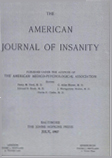THE ADRENALIN BLOOD PRESSURE CURVES IN DEMENTIA PRÆCOX AND THE EMOTIONAL PSYCHOSES
Abstract
Of the thirty-four selected cases of dementia præcox, fifteen were of the catatonic, thirteen of the hebephrenic, four of the paranoid, one of the simple and one of the mixed catatonic and hebephrenic type. In order to eliminate the possible effect of physical diseases on the formation of the adrenalin blood pressure curves, only such patients were submitted to the test who, after thorough examination immediately preceding the test, were found to be free from any acute or chronic physical ailments. Patients with an original blood pressure of more than 165 mm. Hg. were also excluded (with one exception: case 9), since Kylin,8 examining the adrenalin reaction in (non-psychotic) cases of high blood pressure with Dresel's technique, found that in such individuals the pressure curve differed materially from that in persons with a normal blood pressure. In a number of cases the oculocardiac reflex was tested a few days before the injection of adrenalin, and although in several patients pressure on the eyeballs resulted in a considerable reduction of the pulse rate (13 beats in case 1, 15 in case 25, 17 in cases 10 and 22, 35 in case 33, 40 in case 23, 43 in case 19), a constant regularity or a certain parallelism with the configuration of the adrenalin blood pressure curves could not be noticed. The pulse rate after the injection of the drug was at first registered religiously as often as the blood pressure was taken but it was soon found that, due to its continuous fluctuations it could not very well serve as a means for the evaluation of the condition of the vegetative nervous system in the psychosis. As to the adrenalin glycemia, Gordon, Ostrander and Counsell9 recently published a very elucidating paper on the subject, to which the author has nothing to add from his own observations.
The outstanding result of the application of the adrenalin test to the thirty-four cases of dementia præcox was this, that invariably in all individuals examined vagotonic blood pressure curves were obtained. It is true that conditions of excitement in cases 21 and 23 caused at first a sudden rise of the blood pressure, but this was followed soon by a marked drop in case 21, and the other patient who had been submitted to the test once before when he was in a rather stuporous condition yielded a typically vagotonic curve.
The dementia præcox curves could be divided into seven more or less distinct groups. The first group consisting of one case only showed no response whatever, the original blood pressure of 110 mm. remained unaltered. This patient, afterwards, received 2 c. c. of adrenalin, with the effect that the vagus, though hypertonic to a high degree, was not strong enough to counteract the enormous assistance which the sympathicus received and a strongly sympathicotonic curve was the result. The second and third groups show reactions similar to the third vagotonic curve of Dresel, representing a single or double fall of the blood pressure respectively, thus characterizing themselves as being of an extremely vagotonic nature. They were insofar much more outspoken than Dresel's third curve as the fall was not followed by any rise of the blood pressure. In one case, originally diagnosed as manic depressive psychosis, depressed phase, the pressure went down within two minutes to as much as 50 mm. below the original level; later, this patient turned out to be typically catatonic. In the fourth group, comprising eight cases, the initial fall was followed by a more or less pronounced elevation, the highest of which did not exceed 32 mm. Hg. In the four cases of the fifth group, a slight elevation was followed by a depression of the blood pressure curve, again proving the presence of vagus hypertonicity. The eight cases forming the sixth group yielded curves which resembled Dresel's first and second vagotonic curves, showing a delayed and comparatively low elevation. There is finally a seventh group comprising three curves which have the appearance of zigzag-lines and very prettily demonstrate the "tug-of-war" struggle between vagus and sympathicus, with the vagus as winner.
It was naturally more difficult to obtain a large number of acute maniacs or agitated melancholics than cases of dementia præcox for the performance of the test. Only in single cases, it was possible to have the patients cooperate and remain quiet for the approximately sixty minutes required for the adrenalin test. The first group comprised six cases, three were manic, two depressed, and one a constitutional psychopath with manic excitement. A glimpse at the adrenalin blood pressure curves obtained from these patients demonstrate at once their fundamental difference from the dementia præcox curves. They either show sudden elevations occurring within less than ten minutes, or gradual rises which show a very high peak 50-60 mm. above the starting point. Curve 38, taken of a slightly exalted, hypomanic patient, shows accordingly a mildly sympathicotonic curve (with two rises). The three curves of the second manic-depressive group were taken of patients who presented conditions of stuporous melancholia. Here, again, we see marked vagotonic features of the blood pressure curves, with very slight and markedly delayed elevations.
Access content
To read the fulltext, please use one of the options below to sign in or purchase access.- Personal login
- Institutional Login
- Sign in via OpenAthens
- Register for access
-
Please login/register if you wish to pair your device and check access availability.
Not a subscriber?
PsychiatryOnline subscription options offer access to the DSM-5 library, books, journals, CME, and patient resources. This all-in-one virtual library provides psychiatrists and mental health professionals with key resources for diagnosis, treatment, research, and professional development.
Need more help? PsychiatryOnline Customer Service may be reached by emailing [email protected] or by calling 800-368-5777 (in the U.S.) or 703-907-7322 (outside the U.S.).



